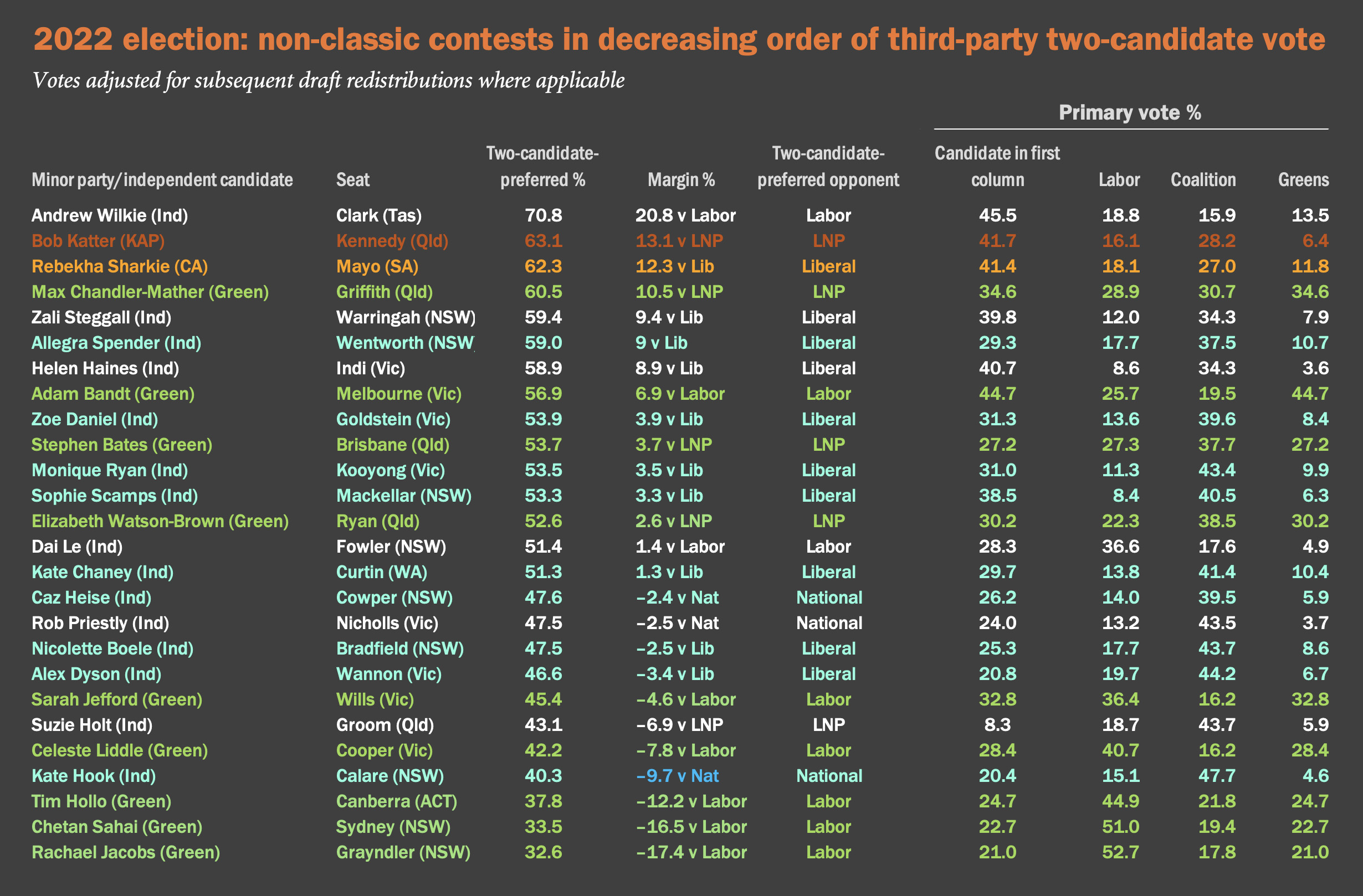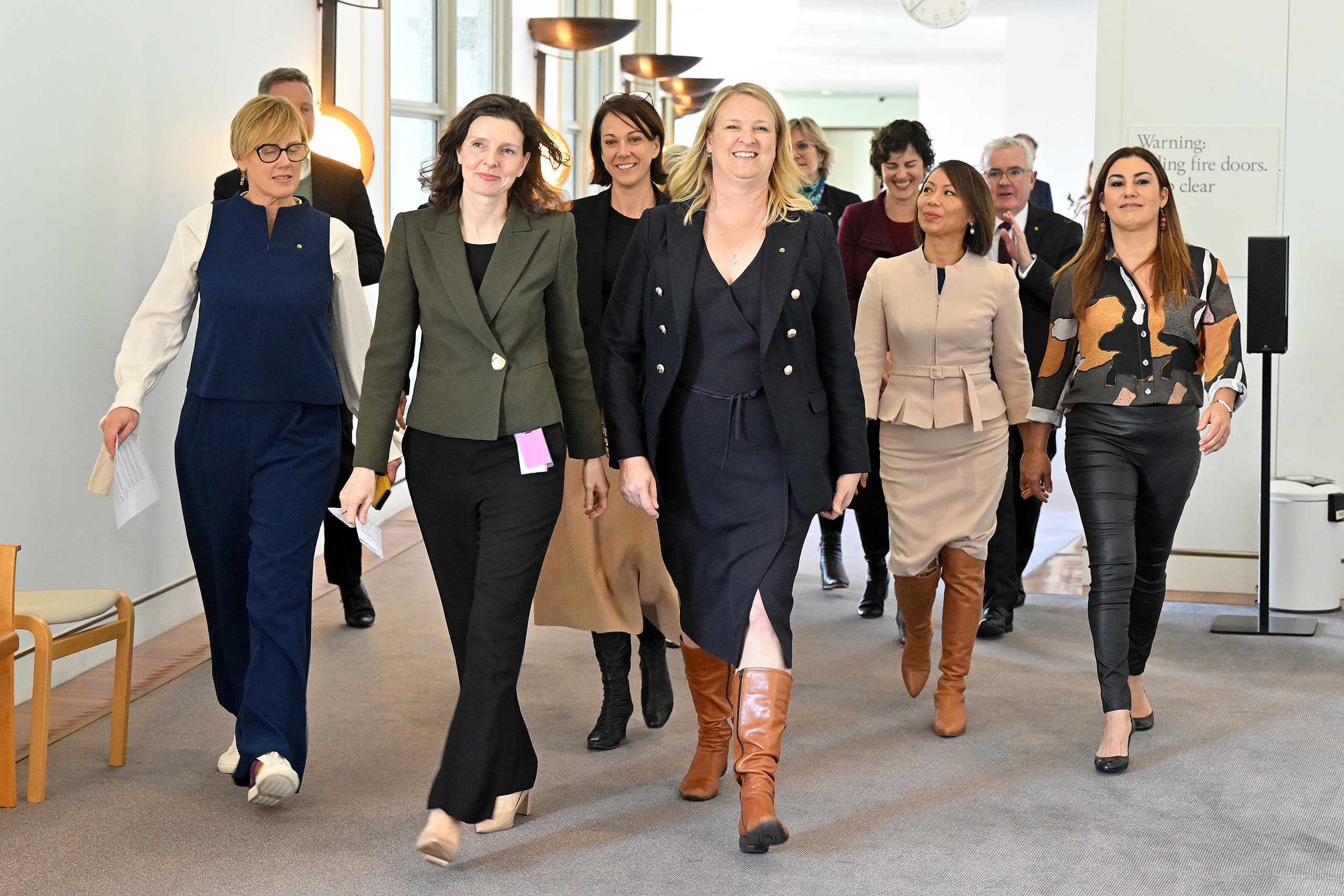What will the House of Representatives crossbench look like after next year’s election? The answer could well determine who forms government.
The current one — sixteen members in the 151-strong chamber — is already the biggest since the two-party system developed in the second decade just over a century ago. The 2022 election produced an unprecedented twenty-seven electorates categorised as “non-classic” by the Australian Electoral Commission (in the sense that the two-candidate-preferred count included an independent or small-party candidate). And the major parties recorded their lowest-ever combined vote of 68.3 per cent.
Current polling has the total majors on about the same level as in 2022, with the Coalition up a couple of points from its 35.7 per cent and Labor down from its 32.6. But polls at the same point in the last term, around August 2021, gave little inkling of what would come, understating independent and minor-party support by around seven to eight points.
There’s one other complication. Since the last election, electoral boundary redistributions have begun in Northern Territory, Western Australia, Victoria and New South Wales. None of the new maps is finalised, but The Tallyroom’s Ben Raue has estimated new margins based on the AEC’s drafts.
I’ve used Ben’s margins (where applicable) in the table below, which lists all non-classics (reduced to twenty-six with the proposed abolition of North Sydney, held by teal Kylea Tink) in decreasing order of their 2022 two-candidate-preferred vote. All of the candidates above 50 per cent are now, of course, sitting MPs. The others were beaten by the party in the “margin” column. The bottom half dozen can’t really be considered possible wins for small parties or independents, but another two electorates that were very competitive aren’t shown in the table.

Sources: Australian Electoral Commission and Ben Raue. Click to enlarge
In Macnamara (Victoria) and Richmond (NSW), the Greens came rather close to entering the final count; had they done so, and had their opponents been Coalition candidates, they would have been comfortably elected. (Neither would have defeated the Labor candidate.) You can see those 2022 results at the AEC here and here; neither has changed much by draft redistributions.
These three-way dances have become more common since 2013, when the Coalition started putting Labor ahead of the Greens on their how-to-vote cards. The policy has made the minor party’s attempts to take ultra-strong Labor seats, as it did in Melbourne in 2010, much more difficult. (Wills, below, might prove an exception.)
While the table shows Max Chandler-Mather’s 10.5 per cent in Griffith as the Greens’ highest margin, his win was actually not as safe as party leader Adam Bandt’s 56.9 per cent share against Labor. Bandt, who entered parliament thanks to the Liberals’ old Greens-before-Labor how-to-vote cards, dug in to the extent that he could withstand the major party’s change in strategy.
Chandler-Mather, by contrast, would have lost to Labor’s Terri Butler in a two-candidate count. The same for Stephen Bates in Brisbane and probably Elizabeth Watson-Brown in Ryan. But only in Brisbane was the ALP sufficiently competitive in primary votes for that to be conceivable.
Wills (see table) deserves special mention. Its notional margin was significantly affected by the draft redistribution, with Labor’s Peter Khalil’s buffer shrinking from 8.6 points to an estimated 4.6. At the next federal poll, Victoria’s government will be more than ten years old, and it has already seriously slumped in state polls. A drop in federal Labor’s primary support in that state could be on the cards, and for this reason, Wills and Macnamara are probably the likeliest Greens gains in 2025.
But will the Greens’ national vote hold up? They clocked in a record 12.2 per cent last time, and recent opinion polls have them at around that. Those mid-to-late 2021 polls averaged roughly a point below their eventual result, so there is nothing in today’s polling numbers to suggest the Greens won’t do as well again in 2025. If anything, the surveys suggest (because they underestimated their support last time) they’ll do better.
Will those three Brisbane newbies survive? If Bandt’s record is anything to go by they’ll romp home, but that single data point is a small sample to project from. The now-leader enjoyed kingmaker status in his first term, extracting (with leader Bob Brown) that “carbon tax” promise from Julia Gillard that did so much to damage her and her government.
Chandler-Mather did best of the new Greens arrivals, and has since enjoyed easily the highest profile of the three. The expression “divides opinion” might have been invented for him. We’ll have to see how that plays out. Probably in his favour, but then he starts from a high 2022 base.
Somewhat mitigating the Greens’ three expected sophomore surges — the personal vote developed by new MPs — is the likelihood that Labor’s primary vote will improve in Queensland thanks to the upcoming defeat of its (also elderly) state government this October. (The inverse of Victoria.)
What about others in the table? Andrew Wilkie, Bob Katter and Rebekha Sharkie are in parliament for as long as they wish to be. Helen Haines also appears secure.
Does Dai Le have staying power, or will Fowler voters decide 2022 was sufficient punishment for Labor? (Presuming to install a wealthy North Shore-ite — albeit their former premier — was an amazing own goal.) But hardly anyone, certainly not me, saw that result coming. Le’s centre-right background adds spice to the mix.
And what about the teals? Their story goes like this: in leafy, wealthy blue-ribbon Liberal territory, long taken for granted, many voters are increasingly estranged from the party’s socially conservative drift, particularly its lack of action on climate change and accompanying rhetoric. Unlike Tony Abbott, Scott Morrison never publicly questioned the science, but his behaviour (the 2017 lump-of-coal-in-question-time springs to mind) suggested he saw little need for Australia to do much about it. And he could be squirm-inducing.
Denizens of these wealthy suburbs remain overall economically dry, and won’t vote Labor. But the high-achieving, articulate teal women — two with serious Liberal pedigrees and all of them cashed up by Climate 200 — proved electable.
This narrative is not without its wrinkles. The blue ribbons are in some cases faded, with eroding partisanship over the decades not only making safe Labor territories less safe against the Liberals (for example in the fabled western Sydney), but also vice versa. At one end of the teal spectrum, Mackellar remains unwinnable for Labor, with the AEC’s 2022 rethrown two-party-preferred count putting the Liberal candidate on 58.8 per cent. At the other, Warringah was pretty line-ball, Liberal 51.4 to Labor 48.6 (admittedly with a dud but high-profile Liberal candidate).
It’s true that large third-party results can distort these notional two-party-preferred numbers, but it’s worth remembering that the two other electorates which might have looked ripe for the teal plucking, but they didn’t contest, Higgins (Victoria) and Ryan, were snatched by Labor and the Greens respectively.
Teal candidates (I don’t include already-sitting MPs) received 2.4 per cent of the national primary vote in 2022 but a whopping 21.7 per cent across the sixteen electorates they contested — an impressive debut assisted by bountiful donations from both inside and outside their electorates. Evidence points to strategic voting by Labor and Greens supporters along with disaffected Liberals, and in ten seats all of this added up to a place in the two-candidate-preferred contest. In six of them, preferences swept teals to victory.
As with Le (and Wilkie and Bandt twelve years earlier) the successful six illustrated how excellent our compulsory preferential voting system can be for independent candidates provided a major party doesn’t “preference” them last (as Labor has always done with One Nation and the Coalition now does with Greens).
Were the teals simply a product of a particular time and place, namely an unpopular Coalition government run by a rather detested prime minister? Those electorates did vote for John Howard four times, and Tony Abbott as prime minister once, but a feature of eroding party loyalty seems to be that old voting habits can take a few terms to break.
The 2025 contest will feature neither Morrison nor a Coalition government. Any disappointment will be directed at Anthony Albanese and his party. Even if no more teals enter parliament, we will still be left with the question of whether the current ones will survive. As other independent and third-party MPs have shown, the slenderest of footholds can be turned into an impenetrable fortress.
Does Zali Steggall provide a glimpse of their future? In some ways she blazed the trail in Warringah in 2019, and in 2022 she picked up several more percentage points. To borrow from Kerry Packer, she could only expect to get one Tony Abbott in her life… except she then got the “captain’s pick” of Katherine Deves and a general anti-Morrison factor in that part of the country.
On paper, Kate Chaney is the most marginal, and she sits in a state, Western Australia, that contributed a huge 9.7 per cent first-preference swing against the Liberal Party. Any noticeable correction to 2022 could sweep her away. But it also comes down to what Curtin voters think of her performance.
We outsiders can form views about which teal MPs seem most impressive, but those deciding their fates might see things differently. And while the five (formerly six) electorates have similarities and can reasonably be categorised together, they of course have different demographics. Some will be inherently more teal-friendly than others. (The to-be-deleted North Sydney has form with independents, electing Ted Mack in 1990 and 1993.)
They don’t call themselves “teals”, of course. They call themselves independents. They differ on some economic issues, with the two Melbourne MPs seeming more “left-wing” than the Sydney three (or four including Steggall) and Chaney in Perth. They vote differently from each other from time to time, but never, to my knowledge, publicly criticise each other.
If the media tends to report on them as a group, does that mean their voters see them that way? If so, does that make them more of a party, where the performance of one member can impact electors’ attitudes the group as a whole, including their own MP?
And, of course, if the Liberals substantially improve their primary vote in 2025 — and opinion polls currently point that way — their chances of victory against the teals, as well as against Labor, will rise.
All of these factors and more are in the mix. But we can say with some certainty that a more socially liberal Liberal leader than Peter Dutton would make the teals’ re-election task more difficult. Thanks to their own successes, there are almost no progressive Libs left in the lower house. (Chaney was the only one of the six who didn’t unseat a card-carrying moderate.)
I haven’t mentioned other parties or semi-groupings, because they’re mostly known unknowns. But last month’s British election gave us one big hint. Those huge votes in Muslim-heavy electorates protesting at the major parties’ sanguine response to the Gaza slaughter put the fear of the almighty into some Labor MPs. Here, as there, any wins would be at the Labor’s expense.
Mathematically, low major-party primary votes don’t have to deliver more MPs to the “other” column. From 2010 to 2019 Labor managed to keep its losses to two (Denison/Clark and Melbourne), even its vote dipped to just 33.3 per cent in 2019. But it does make it more likely. Build the non-major-party vote and the MPs will (probably) come.
What will a table like the one above look like this time next year? The top three will still be there, not necessarily in that order. There will probably be at least the current amount of green, and at least some teal. And others, but exactly who remains to be seen. •





